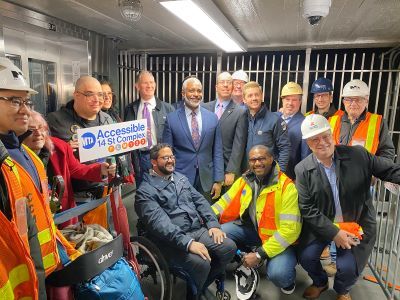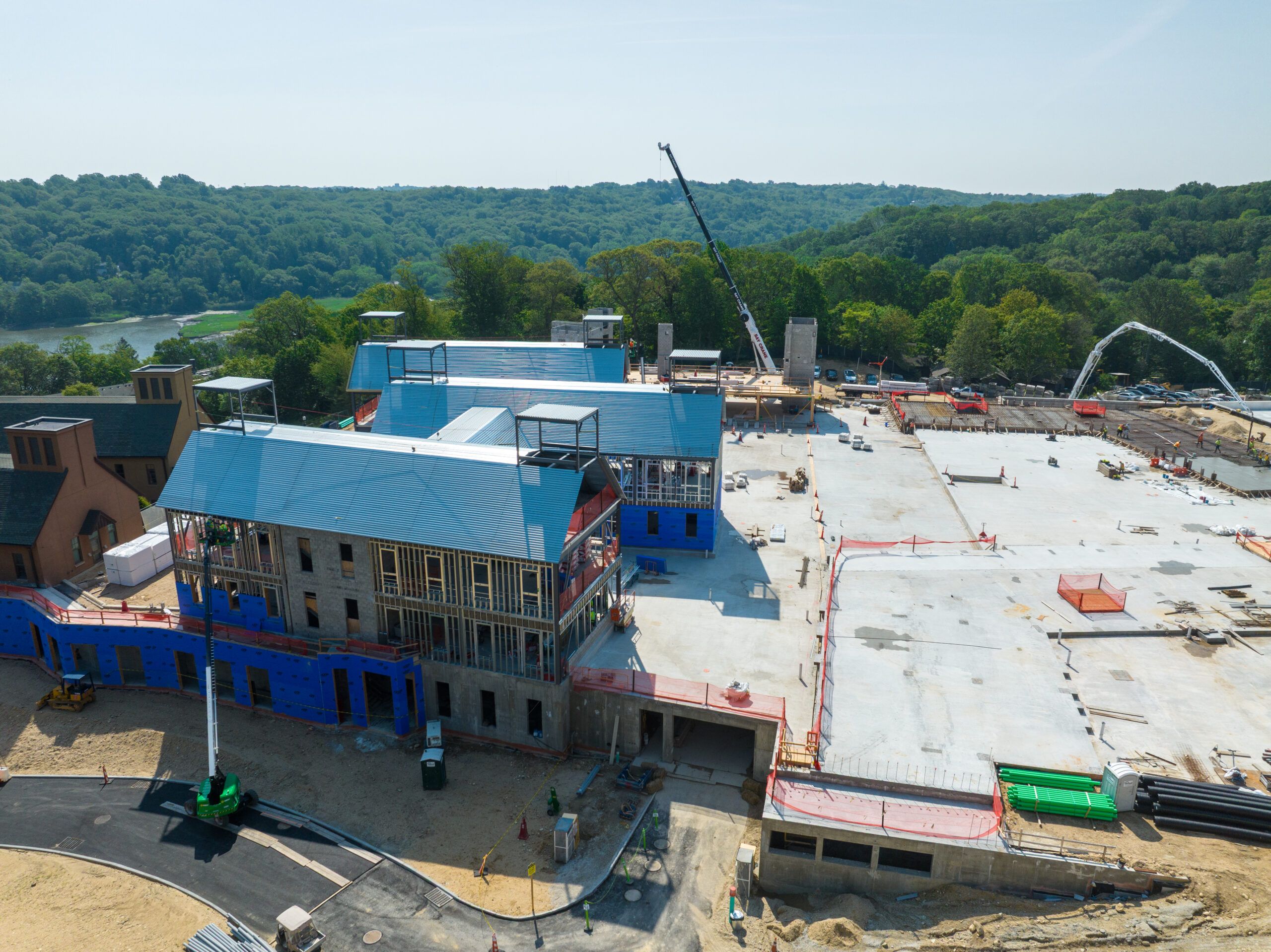The project team of the Metropolitan Transit Authority (MTA), design-build contractor Citnalta-Forte, Joint Venture and designers Urbahn Architects and Gannett Fleming completed a comprehensive accessibility upgrade and other renovations at the 14th Street Sixth Avenue subway station complex in Manhattan. MTA’s subsidiary, MTA Construction and Development (MTA C&D), was the overall project manager. Naik Group served as project management consultant. The team celebrated opening of the final elevator that marks the station’s full accessibility for all passengers.
“The new MTA is completing accessibility projects five times faster than ever before,” said MTA Chair and CEO Janno Lieber. “And one of the main reasons we’re able to open elevators here and throughout the system is the support of the Biden Administration, which contributed $247 million towards this megaproject through USDOT and our congressional delegation, led by Senate Majority Leader Schumer.”
“Newly accessible stations like the 14 Street complex are the fruits of our efforts to deliver projects better, faster, and cheaper,” said MTA Construction & Development President Jamie Torres-Springer. “These accessibility upgrades coupled with critical state of good repair work and station environment improvements have transformed 14 Street into a welcoming transit hub for all New Yorkers.”
“The main goal behind this expansive $300 million upgrade and renovation was to provide full ADA accessibility to the 14th Street Station complex used by more than 130,000 passengers every day. The redesign also included improving passenger circulation and technology upgrades. The station, the oldest section of which was built in 1918, is now fully accessible and received necessary technological, lighting and infrastructure improvements” shared Urbahn Architects Principal Natale V. Barranco, AIA, LEED AP.
The $300 million funding for this ADA upgrade and redevelopment megaproject included $247 million in federal funds.
According to Citnalta President Michael Gargiulo, “The 14th Street Station Complex is one of numerous projects that Citnalta has completed for the MTA throughout its 50-year history. Our work for the New York City Transit system has focused on accessibility upgrades and rehabilitations, resulting in improved passenger comfort, more reliable technology, and increased safety. While this project was extremely challenging, the entire team rose to the occasion to provide elevators and accessibility upgrades that are vital for the riding public.”
“The 14th Street project is part of Urbahn’s ongoing ADA accessibility redesign assignment within MTA’s initiative to make 95% of New York City’s subway stations accessible by 2045. Our firm has designed accessibility upgrades at 16 subway stations in recent years. Improving the daily lives of the New York City community is very gratifying to our entire team,” added Urbahn Project Manager and Senior Associate Lawrence Gutterman, AIA, DBIA.
The complex stretches along West 14th Street between Sixth and Seventh Avenues. It is served by the F and M trains running north and south along Sixth Avenue, the L train along 14 Street, and the 1, 2 and 3 lines running north and south along Seventh Avenue. The three stations have a total of five platforms.
According to Gutterman, “The MTA contracted the project in the design-build method, a process in which a client retains an entire team of contractor, architect, and engineers to deliver both the design and construction under one contract. This method, as opposed to the traditional design-bid-build process, streamlines and accelerates the work, provides one point of responsibility, and improves the overall team collaboration. MTA has been employing this innovative contracting method for several years to deliver multiple ADA upgrades and other renovations throughout the New York City subway system. The design-build process allowed the team to deliver the 14th Street station upgrades on time and on budget, a significant achievement, considering the project’s size and complexity.”
Within the Gannett Fleming – Urbahn joint venture, Urbahn Architects was the architectural lead partner and the architect for the Sixth Avenue portion of the project, while Gannett Fleming was the architect for the Seventh Avenue portion and the structural engineer for the Sixth Avenue portion, as well as the elevator consultant and infrastructure and controls designer. The design-build contract holder and builder was Citnalta-Forte, Joint Venture, formed by Citnalta Construction Corporation and Forte Construction Corporation. Other team members included MEP engineer A. G. Consultant Engineering, structural engineer for the Seventh Avenue portion Dewberry Engineers, communications and fire alarms engineer Geri Goldman Engineering, lighting designer Domingo Gonzalez Associates, and historic restoration consultant Jablonski Building Conservation.
“Design-build is a powerful tool for delivering exceptional projects, allowing us to achieve elevated design standards, while meeting client needs for speed,” added Joe Tulumello, AIA, Gannett Fleming’s Executive Director, Buildings and Places. ”We’re honored to have played a role in the transformative accessibility modernization of the 14th Street Complex. This project reflects our dedication to improving the lives of NYC subway riders through innovative design and engineering and showcases the power of collaboration with Citnalta-Forte and our JV partner, Urbahn Architects.”
In addition to Barranco and Gutterman, Urbahn Architects’ design team included Project Architect Michael Sheedy, AIA, Design Quality Assurance Manager and Senior Associate Nandini Sengupta, Associate AIA and Designer Tom Barcik.
PLANNING, REDESIGN AND CONSTRUCTION
“Early in the project’s design phase, the team surveyed all the underground utilities and structures to gain an understanding of the existing condition of the station complex, evaluate necessary upgrades and select the best locations for the new elevator and stair access points,” explained Urbahn Project Architect Michael Sheedy, AIA.
After determining that the best sites for the majority of street level elevators were where preexisting stairs were located, the team worked to relocate the stairs. Two stairs on the Sixth Avenue side were relocated approximately 30 feet and one stair on the Seventh Avenue side was relocated approximately 100 feet.
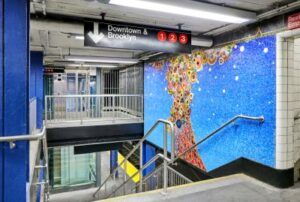
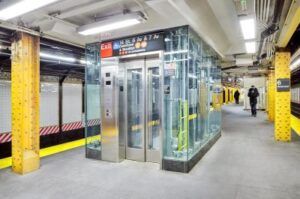
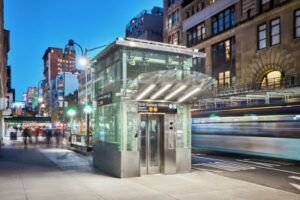
Images Courtesy of: MTA, C&D, URBAHN ARCHITECTS, CITNALTA FORTE & GANNETT FLEMING
The designers and builders addressed numerous logistical and engineering challenges during the design and construction process. In addition to the required relocation of a multitude of utility lines, the team had to reconfigure and expand both the upper and lower mezzanine levels on the Sixth Avenue side in order to create access to the new elevators. They also had to take into account that the southbound and northbound platforms for the F and M lines on the Sixth Avenue side are separated by PATH train tracks and a platform that is operated by the Port Authority of New York and New Jersey, which necessitated the installation of dedicated elevators for each of the subway platforms in this section.
Since the 14th St station is one of the busiest in New York City, the project team had to carefully phase the work to provide continuous, uninterrupted access to the platforms at all times and ensure that the station would remain open throughout the renovations.
“The logistics was the most challenging aspect of the project, as our team had to complete the work without disrupting the commute of 130,000 passengers who use the station daily. Technical challenges included the complex task of excavating the bedrock to the depth of up to 40 feet to install the new elevators next to a busy street and in a densely developed area with an extensive network of underground infrastructure lines,” explained Citnalta’s Project Executive Michael Murphy. “In addition, due to the sections of the complex being originally constructed over 100 years ago, some of the existing conditions, deteriorated structural elements and locations of older infrastructure installations were not discovered until the renovation was already under way. Despite these challenges, we still met the project’s completion schedule by accelerating the work with multiple shifts and working on weekends. In order to achieve full accessibility and improve circulation throughout the station, the project team installed nine new elevators as well as 25 new and 39 renovated stairways, which now take passengers from the street level to the mezzanines and from the mezzanines to the platforms or directly from the street to the platforms. The Sixth Avenue section features six new elevators and the Seventh Avenue segment houses three new elevators.
The team increased circulation capacity throughout the complex by including several new internal stairways that connect the mezzanines to the platforms. For example, previously there was no easy access from the entrance on the west side of the Sixth Avenue to the L train, which forced passengers to cross the mezzanines several times in order to get to the L platform. The new interior stairs resolved this issue.
A new ADA ramp on the pathway between the Sixth Avenue and Seventh Avenue sides was installed to address issues with the preexisting ramp that made it too steep for proper wheelchair access. The new ramp runs approximately half the length of the pathway and was designed at a shallower angle for easier wheelchair use. The ramp is separated with a handrail that runs along the general pathway to allow passengers of varying physical abilities to be able to use the same shared paths. The contractors phased the ramp redevelopment work to ensure safe access and egress for the occupants of the large back-of-house operation in this station complex, which presented a significant logistical challenge.
The large back-of-house operation services almost all of the subway stations in Manhattan. The complex’s upgrades required reconfiguration of these offices and storage rooms, including several areas built early in the project to allow subsequent relocation of the rooms displaced to accommodate the new elevators and elevator machine rooms. The Urbahn team interviewed the back-of-house employees to ascertain their day-to-day needs and ensure that their work would continue uninterrupted.
Other upgrades and repairs included platform surfaces, wayfinding signage and tiled walls in the pathway and within the platform areas. The platforms received new concrete topping slabs to align them seamlessly with elevator landings and train entrances. The platforms now feature new tactile warning strips and indicate ADA boarding zones located directly in front of the trains’ doors.
A new ADA-compliant, accessible agent booth with a lower transaction window was added to the Seventh Avenue side of the station. The entire station features new wayfinding signage as well as new digital interactive Help Point screens that display arrival times and other relevant information about the subway system.
The majority of the lighting fixtures throughout the station were replaced with high-efficiency LED linear fixtures to make them more energy efficient and provide increased levels of lighting that give passengers greater comfort and safety, especially for those who are visually impaired.
The station also features new access control centers consisting of turnstiles and emergency doors, which were included on the lower mezzanine of the Sixth Avenue side of the station and serve the newly created elevator access in that area.
The project team coordinated installation of six new large-scale artwork pieces throughout the station complex. The suite of six mosaics titled Wild Things, is a permanent artwork by Fred Tomaselli. The Brooklyn-based artist, an avid birder, draws from his own multi-sensory bird watching experiences and presents these encounters in his signature style. With a focus on species that live year-round in New York City, temporal reality enters Tomaselli’s imagined world in scenes that include orioles mobbing a falcon, an owl’s gaze, a cosmic cardinal, woodpecker with sonic swirls, a bright sky full of abstract clouds in blue hues, and earth represented by the flaming red petals of a dahlia.
Sections of damaged tiles were replaced with new subway tiles manufactured by Heritage Tile in some of the platform areas and along the underground pathway connecting the Sixth and Seventh Avenue sections.
Outside the station, the New York City Department of Transportation (DOT) designed sidewalk improvements, including curb cuts and street-level elevator access, which were built by the design-build team.
Urbahn Architects
Celebrating its 80th anniversary in 2025, Urbahn Architects is a full-service planning and design firm based in New York City. Since its founding in 1945, Urbahn has designed projects for organizations and institutions that operate in the education, public and governmental, transportation, hospitality, healthcare, science, justice and public safety, residential and infrastructure sectors. The firm also operates a regional office in Jakarta, Indonesia, focused on projects in the Far East. The value of Urbahn’s current domestic and international projects totals approximately $4 billion.
Building Design & Construction magazine ranks Urbahn as the 75th largest architecture and planning firm in the United States. The firm designed some of the nation’s most iconic structures, including the Vehicle Assembly Building and Launch Control at Kennedy Space Center in Cape Canaveral, FL, and the Fermi National Accelerator Lab in Batavia, IL. Four principals lead the firm: Donald E. Henry, Jr., AIA, LEED AP, CPHC; Natale V. Barranco, AIA, LEED AP; Rafael Stein, AIA; and Ranabir Sengupta, AIA, LEED AP.
Urbahn’s transportation project portfolio includes the New York City Transit subway station flood mitigation resiliency program; renovations and accessibility upgrades of multiple MTA subway stations in New York City; numerous projects for the Long Island Rail Road and New Jersey Transit; and Newark City Subway Improvements in Newark, NJ.
Urbahn’s other work includes the 454-unit Tides North residential development in Arverne, NY; 154-room Four Points by Sheraton at the Piarco International Airport, Trinidad and Tobago; 140-room Courtyard by Marriott hotel at the Cheddi Jagan International Airport in Timehri, Guyana; New York City Hall Mayoral Offices and Emergency Situation Center; Centro Medico Correccional in Bayamon, Puerto Rico; Jersey City Municipal Services Complex, Jersey City, NJ; SUNY New Paltz Engineering Innovation Hub in New Paltz, NY; Lehman College School of Nursing in the Bronx, NY; Usha Martin University Master Plan in Ranchi, India; Columbia University Baker Field Facilities Master Plan in New York, NY; and P.S. 253Q Elementary School in Queens, NY.
Citnalta-Forte Joint Venture
Citnalta-Forte Joint Venture (CFJV) is proud to have come together once again to successfully complete Contract A37129 Design-Build Services for the 14th Street ADA Complex. CFJV was first formed in 2016 to design and construct the MTA NYCT’s design-build (DB) Enhanced Station Initiative (ESI) Package 1 – 3 Stations Project. Since then, CFJV has worked together on several other MTA design-build projects, frequently with Urbahn Architects as design partner.
Citnalta Construction Corporation
Established in 1974 and based in Bohemia, New York, Citnalta Construction Corp. is a leading design-builder, construction manager and general contractor in the New York Metropolitan area. Throughout its 50-year history, Citnalta’s clients have included private and public owners such as MTA Construction & Development, New York City Transit Authority, New York City School Construction Authority, Dormitory Authority State of New York, Long Island Rail Road, New York State Department of Design and Construction and New York Office of General Services, among others.
Forte Construction
Forte Construction Corp. is a prominent player in the field of design-build contracting. Established in 2010, the firm is a wholly owned affiliate of TAP Electrical Contracting Service, Inc. Forte’s core expertise focuses on large-scale public infrastructure projects, primarily catering to government agencies such as the Metropolitan Transportation Authority Construction & Development (MTA C&D), Long Island Rail Road (LIRR), New York City Transit (NYCT), Metropolitan Transportation Authority Bridges & Tunnels (MTA B&T), School Construction Authority (SCA), Dormitory Authority of the State of New York (DASNY), New York City Housing Authority (NYCHA), and Amtrak.
Gannett Fleming TranSystems
Gannett Fleming TranSystems is a privately held, best-in-class architecture, engineering, and construction firm partnering closely with clients on some of the most complex challenges facing communities today. Across North America, from more than 130 locations, the firm offers comprehensive infrastructure consulting services to a wide range of markets, including transportation, water resources, civic, education, federal, industrial, power, and life sciences. The firm’s depth of staff and breadth of experience provides clients with integrated services on projects of any. The company’s professionals include planners, architects, scientists, engineers, and construction managers, who are innovators, problem solvers, thought leaders, trainers, authors, and educators working together to deliver excellence on their projects. Bringing the specialized expertise that our clients need to thrive in a rapidly changing world, Gannett Fleming TranSystems focuses on making our communities and infrastructure better connected and safer, as well as more resilient and sustainable.
Feature Image Courtesy of: MTA, C&D, URBAHN ARCHITECTS, CITNALTA FORTE, & GANNETT FLEMING




